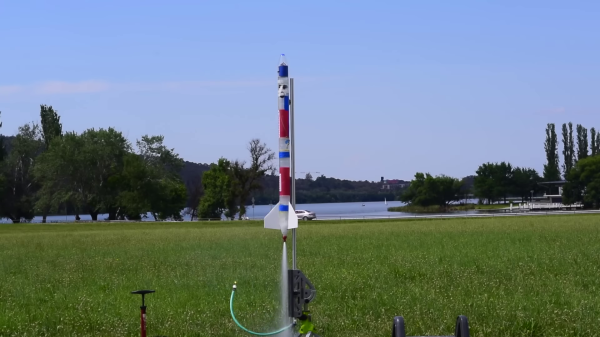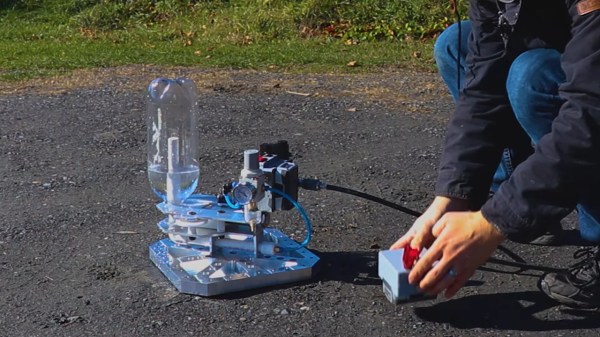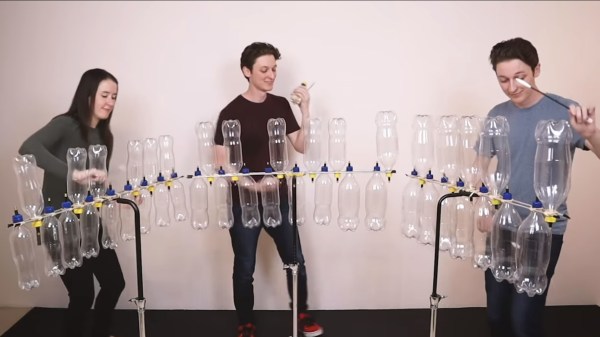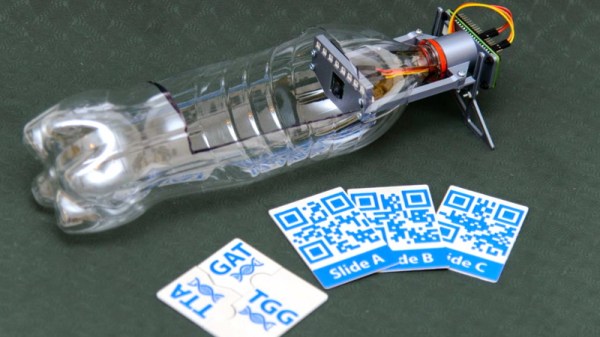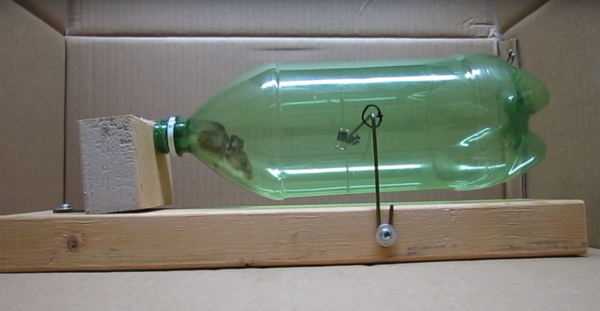It’s been a while since we’ve dunked on an autonomous taxi foul-up, mainly because it seemed for a while there that most of the companies field testing driverless ride-sharing services had either ceased operation or curtailed them significantly. But that appears not to be the case after a Waymo robotaxi got stuck in a Chick-fil-A drive-through. The incident occurred at the chicken giant’s Santa Monica, California location at about 9:30 at night, when the autonomous Jaguar got stuck after dropping off a passenger in the parking lot. The car apparently tried to use the drive-through lane to execute a multi-point turn but ended up across the entrance, blocking other vehicles seeking their late-evening chicken fix. The drive-through-only restaurant ended up closing for a short time while Waymo figured out how to get the vehicle moving again.
soda bottle13 Articles
Massive Water Rocket Is Impressive But Accessible
Water rockets are one of those projects that never get old, and bumping the size just adds to the challenge. In the video after the break, [ARRO Rockets] takes us through the launch of Gamma IV, his most ambitious water rocket project yet. Crafted with spliced soda bottles and standard household materials, this rocket is a testament to what one can achieve with simple components and a bit of ingenuity.
The rocket’s release mechanism demonstrates this — employing nothing more than a quick connect hose connection and a basic pulley system. The parachute recovery system is also a nice combo of modern electronics and simplicity. It uses a microcontroller with accelerometer to detect the apogee, and release the parachute to be ejected by another piece of soda bottle acting as a spring. It also records or the flight data on an SD card.
[ARRO Rockets] had some trouble with friction on the launch rail, which was partially solved with liberal application of silicone spray. The root cause might be the rail button flexing on launch, or just the change of the pressurized bottles.
We are especially impressed by how accessible this project is, a reminder that high-flying achievements don’t necessarily require deep pockets or hard-to-source parts. The entire setup is not only cost-effective but also opens up numerous possibilities for further experimentation and refinement, like adding a second stage or a precision release mechanism.
Continue reading “Massive Water Rocket Is Impressive But Accessible”
Robust Water-Rocket Launcher Gets The Engineering Just Right
Normally when we run across a project that claims to be overengineered, we admit that we get a little excited. Such projects always hold the potential for entertainingly over-the-top designs, materials, and methods. In this case, though, we’ll respectfully disagree with [Zach Hipps] assessment of his remote-controlled soda bottle rocket launcher as “overengineered”. To us, it seems just right.
That’s not to take away from anything accomplished with this build. Indeed, we’re mighty impressed by the completeness of the build, which was intended to create a station for charging and launching air-powered water rockets. The process started with a prototype, built mainly from 3D-printed parts but with a fair selection of workshop scraps to hold it together. This allowed [Zach] to test the geometry of the parts, operation of the mechanism, and how it interfaced with the flange on the necks of 2-liter soda bottles.
Honestly, the prototype was pretty good by itself and is probably where many of us would have stopped, but [Zach] kept going. He turned most of the printed parts into machined aluminum and Delrin, making for a very robust pneumatically operated stand. We’ve got to say the force with which the jaws close around the bottle flange is a bit scary — looks like it could easily clip off a wayward finger. But if he manages to avoid that fate, such a hearty rig should keep [Zach] flying for a long time. Perhaps it could even launch a two-stage water rocket?
Continue reading “Robust Water-Rocket Launcher Gets The Engineering Just Right”
Pouring Creativity Into Musical Upcycling Of Plastic Bottles
Convenient and inexpensive, plastic beverage bottles are ubiquitous in modern society. Many of us have a collection of empties at home. We are encouraged to reduce, reuse, and recycle such plastic products and [Kaboom Percussion] playing Disney melodies on their Bottlephone 2.0 (video embedded below) showcases an outstanding melodic creation for the “reuse” column.
Details of this project are outlined in a separate “How we made it” video (also embedded below). Caps of empty bottles are fitted with commodity TR414 air valves. The pitch of each bottle is tuned by adjusting pressure. Different beverage brands were evaluated for pleasing tone of their bottles, with the winners listed. Pressure levels going up to 70 psi means changes in temperature and inevitable air leakage makes keeping this instrument in tune a never-ending task. But that is a relatively simple mechanical procedure. What’s even more impressive on display is the musical performance talent of this team, assisted by some creative video editing. Sadly for us, such skill does not come in a bottle. Alcohol only makes us believe we are skilled without improving actual skill.
But that’s OK, this is Hackaday where we thrive on building machines to perform for us. We hope it won’t be long before a MIDI-controlled variant is built by someone, perhaps incorporating an air compressor for self-tuning capabilities. We’ve featured bottles as musical instruments before, but usually as wind instruments like this bottle organ or the fipple. This is a percussion instrument more along the lines of the wine glass organ. It’s great to see different combinations explored, and we are certain there are more yet to come.
Continue reading “Pouring Creativity Into Musical Upcycling Of Plastic Bottles”
Teaching Science With An Empty Soda Bottle
Creating the next generation of scientists and engineers starts by getting kids interested in STEM at an early age, but that’s not always so easy to do. There’s no shortage of games and movies out there to entertain today’s youth, and just throwing a text book at them simply isn’t going to cut it anymore. Modern education needs to be engrossing and hands-on if it’s going to make an impact.
Which is exactly what the Institute of Science and Technology Austria hopes to accomplish with the popSCOPE program. Co-founded by [Dr. Florian Pauler] and [Dr. Robert Beattie], the project uses off-the-shelf hardware, 3D printed parts, and open source software to create an engaging scientific instrument that students can build and use themselves. The idea is to make the experience more personal for the students so they’re not just idle participants sitting in a classroom.
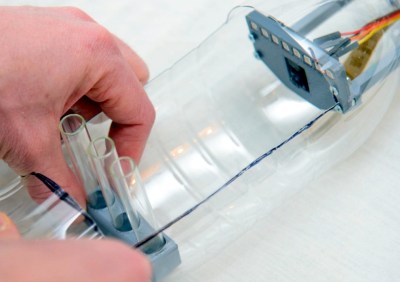 The hardware in use here is quite simple, essentially just a Raspberry Pi Zero W, a camera module, a Pimoroni Blinkt LED module, and a few jumper wires. It all gets bolted to a 3D printed frame, which features a female threaded opening that accepts a standard plastic soda (or pop, depending on your corner of the globe) bottle. You just cut a big opening in the side of the bottle, screw it in, and you’ve saved yourself a whole lot of time by not printing an enclosure.
The hardware in use here is quite simple, essentially just a Raspberry Pi Zero W, a camera module, a Pimoroni Blinkt LED module, and a few jumper wires. It all gets bolted to a 3D printed frame, which features a female threaded opening that accepts a standard plastic soda (or pop, depending on your corner of the globe) bottle. You just cut a big opening in the side of the bottle, screw it in, and you’ve saved yourself a whole lot of time by not printing an enclosure.
So what does the gadget do? That obviously comes down to the software it’s running, but out of the box it’s able to do time-lapse photography which can be interesting for biological experiments such as watching seeds sprout. There’s also a set of 3D printable “slides” featuring QR codes, which the popSCOPE software can read to show images and video of real microscope slides. This might seem like cheating, but for younger players it’s a safe and easy way to get them involved.
For older students, or anyone interested in homebrew scientific equipment, the Poseidon project offers a considerably more capable (and complex) digital microscope made with 3D printed parts and the Raspberry Pi.
Propane-Powered Plasma Rifle
It may not be a “phased plasma rifle in the 40-watt range,” and it doesn’t even use plasma in the strict definition, but it’s pretty cool nonetheless. It’s a propane-powered bottle-launching rifle, and it looks like a lot of fun.
[NighthawkInLight] sure likes things that go pop, like his watermelon-wasting air-powered cannon and cheesy-poof pop gun. This one has a little more oomph to it, powered as it is by a propane torch. The principle is simple: fill a soda bottle with propane, ignite the gas, fun ensues. The details are a little more subtle, though, and allowances need to be made to keep back pressure from preventing the projectile from filling with fuel. [NighthawkInLight] overcomes this with some clever machining of the barrel. The final production version in the video below is needlessly but delightfully complex, with a wooden stock and a coil of clear vinyl tubing helical plasma accumulator before the barrel; the last bit is just for show, and we have to admit that it looks pretty good.
Unless you count the pro tip on using CPVC pipe to make custom fittings, this one is nothing but fun. But we don’t have a problem with that.
A Better Mousetrap, At Least For The Mouse
No mice were harmed in the making of this non-lethal soda bottle mousetrap.
Depending on your opinion of these little critters, that could be a good thing or a bad thing. We don’t deny that mice are cute as all get-out, but when they do damage to foodstuffs that you’ve put an entire summer’s effort into growing, harvesting and preserving, cute isn’t worth much.
Our preference for taking care of rodent problems is either bioremediation or rapid cervical dislocation, but if you’re more of the catch-and-release type, this trap is for you. It’s just a 2-liter soda bottle on a wire pivot and mounted to a scrap wood frame; when the offending critter unwisely enters the neck of the bottle, its weight flips the bottle down and blocks the exit. Release is as simple as removing the bottle from the frame and letting Monsieur Jingles wiggle free. The questions of where to release and how many times you’ll keep catching the same mouse are left as an exercise for the reader.
Remember – a live catch trap is only humane if it’s checked regularly. To that end, maybe something like das Katzetelegraf could be added to this trap.
Continue reading “A Better Mousetrap, At Least For The Mouse”


